Microscopic Examination of Biosynthesis of Anthocyanins in Leaves of Vigna radiata under Saline Stress; a New Insight
| Received 11 Mar, 2024 |
Accepted 22 May, 2024 |
Published 15 Jun, 2024 |
The irrigation water used for the cultivation of crops contains soluble substances like Cl, SO4, CO3, and others, referred to as salts, necessary for plant growth. The salinity may recover soil texture while, on the other hand, it inhibits plant growth and reduces crop yields if in excesses. The current article aims to monitor the visual accumulation of anthocyanin in the leaves of plant Vigna radiata cultivated under salinity in a half-strength Hogland solution. Anthocyanins extracted from plants are generally used as natural colours in cosmetics, dyes, and food additives. The relationships between salt stress and anthocyanin content in leaves of Vigna radiata were investigated under a photo camera microscope. The experiment was conducted after 2 days of germination in the dark and then shifted into nutrient media viz 0, 15, 20, and 25 ppm NaCl. Visual monitoring revealed the reduction in plant growth directly related to the increase in salinity. The leaves were harvested after 15 days, washed, cleaned and subjected to monitored anthocyanin synthesis under a photo camera microscope. It was observed that the red and purple regions in leaves appeared under salinity and were found to increase as NaCl concentration increased. The colour of anthocyanins reveals the presence of flavonols, dihydro flavonols, and hydroxycinnamic acids. The highest anthocyanin content (red and purple regions in leaves) was observed under high salinity conditions (25 ppm). Microscopic evaluation of leaves recommended that more searches be undertaken to enhance anthocyanin contents under salinity in anthocyanins-rich fruits and vegetables that may be extracted for antioxidant, anti-inflammatory, pharmacological and other diet purposes.
INTRODUCTION
Anthocyanin pigments play a role in developing the colour of plants' fruits, flowers, leaves, and roots. Its biosynthesis signifies a substantial metabolic asset for the development of plant cells. The biosynthesis of the anthocyanin implies the plant's protective system against stress and develops tolerance mechanisms stimulated by excess reactive oxygen species (ROS). It act as ROS scavengers, protecting against oxidative damage and enhancing their sustainability (Brodribb et al., 2010; Borghesi et al., 2011; Xu et al., 2017). Salinity refers to any salt in the soil that limits plant water availability; consequently, high electrical conductivities are observed.It is a problem due to the presence of high amounts of salt near the roots of the plants, which makes them unable to take water from the soil (Al-Busaidi & Cookson 2003). Although water preservation in the soil is not increased in saline surroundings, salt in the water stimulates plants to expend more energy in extracting water from the soil. Soil water salinity also increases as plants take up or lose water through transpiration, increasing salt and concentrating it in the remaining soil water (Li et al., 2022).
Osmosis is the process by which water moves into the plant from the roots, while if salt in soil water is high, osmosis will slow down; consequently, dehydration occurs, leading to a decline in growth or death of the plant. Salinity affects the growth of plants due to certain specific ions like chloride that are lethal to plants when in excesses. The leaves of most of the higher plants are green in colour, showing the presence of chlorophyll and other light-harvesting pigments to carry on photosynthesis (Nishio, 2000). Anthocyanins are allied with improved resistance to environmental stresses, including abiotic and biotic. The colour and stability of anthocyanin pigments are influenced by pH, light, temperature, and structure. It appears red in acidic soil while blue under alkaline conditions of the soil (Farooq et al.,2022). It was reportedby Al-Busaidi et al. (2003) that the pH of the soil decreases as the salinity of the soil increases, possibly due to the inverse correlation between soil pH and the enhanced solubility of Ca2+ ions in saline soil under typical atmospheric CO2 concentrations, that lead to a release of hydrogen ions. Another report described that 2 fold increase in saline treatment in the plant Sun Black enhanced the synthesis of anthocyanins in fruits (Borghesi et al., 2011). The use of anthocyanins in the food and pharma industry is widespread and extracted from several types of fruits and vegetables.
Moreover, anthocyanins exhibit antidiabetic, anticancer, anti-inflammatory, antimicrobial, and anti-obesity properties and assist in preventing cardiovascular diseases. Consequently, anthocyanins derived from edible plants are promising pharmaceutical compounds (He et al., 2011). Therefore, the present investigation was undertaken to examine the leaves of Vigna radiata cultivated under diverse saline conditions to check anthocyanin contents visually under a microscope and to determine whether salinity may enhance the anthocyanin contents in anthocyanin-rich fruits and vegetables.
MATERIAL AND METHODS
Chemically sterilized seeds of Vigna radiata were washed thoroughly with distilled water and dried on filter paper. These seeds were transferred to sterilized petri plates and placed in the dark for two days. The two-day-old germinated seeds were placed in a half-strength Hoagland solution. Control plants were grown using a half-Hoagland solution without NaCl. All plants were placed under a natural environment where saline treatments were done viz 0.0,15,20, and 25 ppm. The solution was patterned daily to check the plants for further additions of the half-Hoagland solution during 15 days of growth. After 15 days, harvested plants were weighed, and their length was recorded while leaves were cleaned according to the Koga & Kobayashi (1980) method to observe the synthesis of anthocyanins using a photo camera microscope.
RESULTS AND DISCUSSION
Leaves clearing is valuable for numerous ecological, physiological, eco-physiological, taxonomical, ecological, and eco-physiological aspects of research (Bruzzese & Hasan 1983). The primary function of leaves is harvesting solar radiation to synthesize glucose. Its further polymerization is related to plant growth, which is affected by environmental conditions and may be used to observe the ecological impact on primary reactions due to reduced plant growth (Farooq et al., 2022; Brodribb et al., 2010).
The biosynthesis of anthocyanins was inspected microscopically under salinity in the leaves of Vigna radiata. It was observed that the growth of the plants was affected under salinity, as shown in Fig.(1).
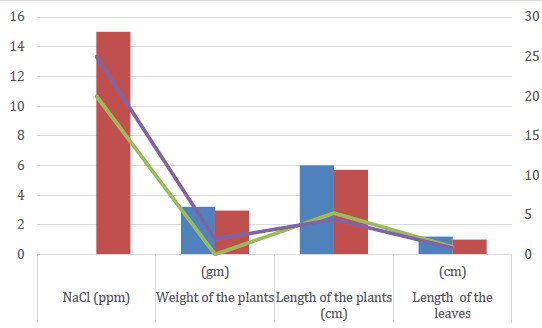
|
It was reported that the yield and quality of crops were reduced under salt stress, similar to the current study, which threatened the supply of food to achieve the target of the population due to the higher dry matter accumulation in plants directly correlated with the increased synthesis of anthocyanin content in wheat that enhance salt tolerance (Mbarki et al., 2018). Salinity significantly impacts plant cell membranes' permeability, which is responsible for physiological drought in plants, photosynthesis, respiration, growth, and yield (Kim et al., 2022). It was established that salinity limits the growth of the plants, consequently limiting the yield (Fig.1). The harvested leaves, after clearing, were placed under a microscope where no anthocyanin contents (Fig. 2) were observed in control plants, indicating the normal metabolism of the plants.
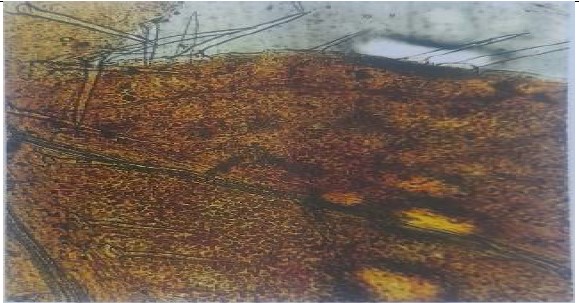
|
The leaves of the Vigna radiata in low salinity (Fig.3 ) exhibited a shallow red colour, indicating the synthesis of anthocyanins underway in the trichomes (Zhang et al. 2016) under salinity, followed by fading of the green colour in this region.
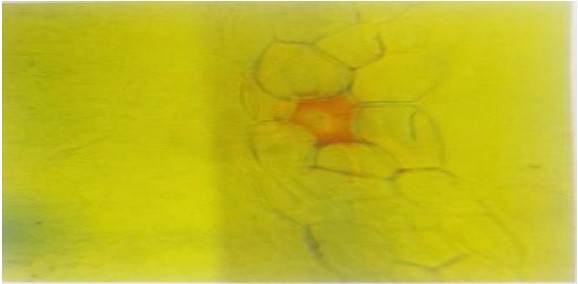
|
Microscopic examination of leaves grown under 20 and 25 ppm exposed red and purple regions with less green regions display the synthesis of anthocyanins directly related to enhanced saline conditions (Fig. 4 &5) compared to control plants (Fig.2).
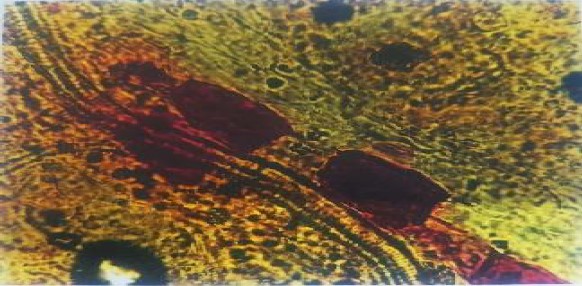
|
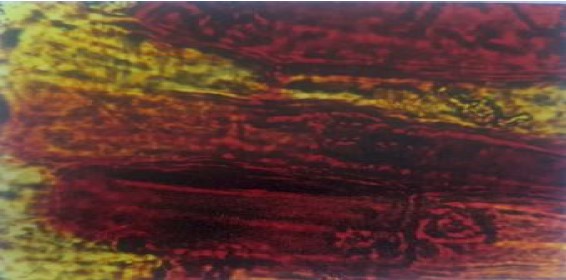
|
Zhang et al. (2016) reported that the synthesis occurs in the cytosol, a platform for cellular metabolic processes and reactions (containing 70% water) and is transported to the vacuole region, which is found to be enhanced as salinity increases. It is also supported by the earlier reports that a large number of anthocyanin trichomes contributed to the red region, which may be for the protection of photosystem 1 (Zhang et al. 2016). Plant physiology and metabolism are disturbed under salinity through oxidative and osmotic stress, ion toxicity,and nutrient imbalance, stimulating cellular damage, reducing growth and yield observed and even plant death (Ma et al.,2021; Muchate et al., 2016). This may also lead to modifying diverse anthocyanin derivatives, which are then transported to vacuoles. Zhao et al. (2023) reported more than hundreds of unique anthocyanins, and several enzymes are involved in their modification; however, these late modification pathways are primarily unidentified (Zhao et al. 2023). It increases the capability of the antioxidant system to overcome the salinity. Furthermore, anthocyanin was shown to help plants cope with salt stress under nitrate-deficient conditions, similar to the present research project where major red and purple regions indicate the scavenging capability of ROS by anthocyanin pigment. The microscopic examination of the leaves is also supported by Gould's report. (2004), who established that red pigment in wounded leaf peels under the microscope may be involved in eliminating H2O2significantly higher than green cells. He also stated that scavenging of H202 may occur primarily by the red tautomers of anthocyanin found inside the cell vacuole or by the colourless tautomers in the cytosol, both of which showed good antioxidant capability. Neill, & Gould. (2003) conducted an in vitro study where they observed that colourless tautomers proved effective in scavenging the oxidative species, contributing to developing a defence system against ROS. High salinity inhibits the absorption of essential mineral nutrients and disrupts the dynamic balance of K+ and Na+ in new and old leaves (Ismail and Horie, 2017). ROS is generally generated under salinity, biotic and abiotic stresses, which negatively affects chlorophyll content (Fig.3-5) and photosynthetic rate (Kim et al., 2022). The function of anthocyanins is to regulate the ROS species as they may interact with protein to augment protein activity through the ROS reaction. The current investigation proves that anthocyanin biosynthesis is enhanced under salinity. Still, it is not usually a requirement for protection from oxidative stress. Microscopic examination of Fig. (4 & 5) showed the red and purple pigments, similar to earlier reports of Shi and Xie, 2014 who established that anthocyanin (purple pigment) played a significant role in plant protection from UV light, ROS, resistant to abiotic stress and also involved in attracting pollinators (Khan et al.,2020). Besides all these, it was also recommended that salinity might be beneficial for the extraction of anthocyanins to use as an antioxidant, anti-inflammatory bioactive compounds and other uses in the cosmetics, food, and beverages industry if saline stress applied on anthocyanins-enriched fruits and vegetables (Jaakola, 2013).
CONCLUSION
The current search gives new insight into salinity and anthocyanin accumulation that may help in extracting organic anthocyanins from plants grown with different stresses. Based on current findings, plants enriched in anthocyanins should be tested and grown under saline conditions to enhance their anthocyanins. Therefore, more investigation is suggested at an advanced level to improve the concentration of anthocyanins in plants under saline soil and their safe extraction so they can be applied as a green compound for industrial purposes.
ACKNOWLEDGMENT
Author is very thankful to the National Nematode Research Center for providing the facilities of the photo camera Microscope and to the Department of Botany Jinnah University for Women Nazaimabad for conducting this study.
REFERENCES
- Al-Busaidi, A. S., & Cookson, P. (2003). Salinity–pH relationships in calcareous soils.Journal of Agricultural and Marine Sciences [JAMS], 8(1), 41-46.
- Brodribb, T. J., Feild, T. S., & Sack, L. (2010). Viewing leaf structure and evolution from a hydraulic perspective.Functional Plant Biology, 37(6), 488-498.
- Borghesi, E., González-Miret, M. L., Escudero-Gilete, M. L., Malorgio, F., Heredia, F. J., & Meléndez-Martínez, A. J. (2011). Effects of salinity stress on carotenoids, anthocyanins, and color of diverse tomato genotypes.Journal of Agricultural and Food Chemistry, 59(21), 11676-11682.
- Bruzzese, E., & Hasan, S. (1983). A whole leaf clearing and staining technique for host specificity studies of rust fungi.Plant pathology, 32(3).
- Farooq, M., Khan, M. A., Zhao, D. D., Asif, S., Kim, E. G., Jang, Y. H., ... & Kim, K. M. (2022). Extrinsic role of gibberellin mitigating salinity effect in different rice genotypes.Frontiers in Plant Science, 13, 1041181.
- Khan, A., Jalil, S., Cao, H., Tsago, Y., Sunusi, M., Chen, Z., ... & Jin, X. (2020). The purple leaf (pl6) mutation regulates leaf color by altering the anthocyanin and chlorophyll contents in rice.Plants, 9(11), 1477
- Koga, H., & Kobayashi, T. (1980). A whole-leaf clearing and staining technique to observe the invaded hyphae of blast fungus and host responses in rice leaves.Japanese Journal of Phytopathology, 46(5), 679-681.
- Kim, M. S., Kim, J. H., Amoah, J. N., & Seo, Y. W. (2022). Wheat (Triticum aestivum. L) Plant U‐box E3 ligases TaPUB2 and TaPUB3 enhance ABA response and salt stress resistance in Arabidopsis.FEBS letters, 596(23), 3037-3050.
- Gould, K. S. (2004). Nature's Swiss army knife: the diverse protective roles of anthocyanins in leaves.Journal of Biomedicine and Biotechnology, 2004(5), 314.
- He, K., Li, X., Chen, X., Ye, X., Huang, J., Jin, Y., ... & Shu, H. (2011). Evaluation of antidiabetic potential of selected traditional Chinese medicines in STZ-induced diabetic mice.Journal of ethnopharmacology, 137(3), 1135-1142.
- Jaakola, L. (2013). New insights into the regulation of anthocyanin biosynthesis in fruits.Trends in plant science,18(9), 477-483.
- Li, Z., Zhu, L., Zhao, F., Li, J., Zhang, X., Kong, X., H. Wu & Zhang, Z. (2022). Plant salinity stress response and nano-enabled plant salt tolerance.Frontiers in Plant Science, 13, 843994.
- Mbarki, S., Sytar, O., Cerda, A., Zivcak, M., Rastogi, A., He, X., Abdelly,C & Brestic, M. (2018). Strategies to mitigate the salt stress effects on photosynthetic apparatus and productivity of crop plants.Salinity Responses and Tolerance in Plants, Volume 1: Targeting Sensory, Transport and Signaling Mechanisms, 85-136.
- Muchate, N. S., Nikalje, G. C., Rajurkar, N. S., Suprasanna, P., & Nikam, T. D. (2016). Plant salt stress: adaptive responses, tolerance mechanism and bioengineering for salt tolerance.The Botanical Review, 82, 371-406.
- Neill, S. O., & Gould, K. S. (2003). Anthocyanins in leaves: light attenuators or antioxidants?.Functional Plant Biology, 30(8), 865-873.
- Nishio, J. N. (2000). Why are higher plants green? Evolution of the higher plant photosynthetic pigment complement.Plant, Cell & Environment, 23(6), 539-548.
- Ma, Y., Ma, X., Gao, X., Wu, W., & Zhou, B. (2021). Light induced regulation pathway of anthocyanin biosynthesis in plants.International journal of molecular sciences, 22(20), 11116.
- Shi, M. Z., & Xie, D. Y. (2014). Biosynthesis and metabolic engineering of anthocyanins in Arabidopsis thaliana.Recent patents on biotechnology, 8(1), 47-60.
- Xu, Z., Mahmood, K., & Rothstein, S. J. (2017). ROS induces anthocyanin production via late biosynthetic genes and anthocyanin deficiency confers the hypersensitivity to ROS-generating stresses in Arabidopsis.Plant and Cell Physiology, 58(8), 1364-1377.
- Zhao, Y., Jiang, C., Lu, J., Sun, Y., & Cui, Y. (2023). Research progress of proanthocyanidins and anthocyanidins.Phytotherapy Research, 37(6), 2552-2577.
- Zhang, T. J., Chow, W. S., Liu, X. T., Zhang, P., Liu, N., & Peng, C. L. (2016). A magic red coat on the surface of young leaves: anthocyanins distributed in trichome layer protect Castanopsis fissa leaves from photoinhibition.Tree physiology, 36(10), 1296-1306.
How to Cite this paper?
APA-7 Style
Nasreen,
H. (2024). Microscopic Examination of Biosynthesis of Anthocyanins in Leaves of Vigna radiata under Saline Stress; a New Insight. Journal Advances of Nutrition Science and Technology, 4(1-2), 35-40. https://doi.org/10.15228/ANST.2024.v04.i01-2.p04
ACS Style
Nasreen,
H. Microscopic Examination of Biosynthesis of Anthocyanins in Leaves of Vigna radiata under Saline Stress; a New Insight. J. Adv. Nutri. Sci. Tech. 2024, 4, 35-40. https://doi.org/10.15228/ANST.2024.v04.i01-2.p04
AMA Style
Nasreen
H. Microscopic Examination of Biosynthesis of Anthocyanins in Leaves of Vigna radiata under Saline Stress; a New Insight. Journal Advances of Nutrition Science and Technology. 2024; 4(1-2): 35-40. https://doi.org/10.15228/ANST.2024.v04.i01-2.p04
Chicago/Turabian Style
Nasreen, Hajra.
2024. "Microscopic Examination of Biosynthesis of Anthocyanins in Leaves of Vigna radiata under Saline Stress; a New Insight" Journal Advances of Nutrition Science and Technology 4, no. 1-2: 35-40. https://doi.org/10.15228/ANST.2024.v04.i01-2.p04

This work is licensed under a Creative Commons Attribution 4.0 International License.


